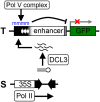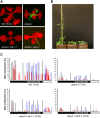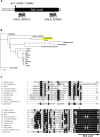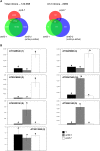An Rtf2 Domain-Containing Protein Influences Pre-mRNA Splicing and Is Essential for Embryonic Development in Arabidopsis thaliana
- PMID: 25819795
- PMCID: PMC4492377
- DOI: 10.1534/genetics.115.176438
An Rtf2 Domain-Containing Protein Influences Pre-mRNA Splicing and Is Essential for Embryonic Development in Arabidopsis thaliana
Abstract
Alternative splicing is prevalent in plants, but little is known about its regulation in the context of developmental and signaling pathways. We describe here a new factor that influences pre-messengerRNA (mRNA) splicing and is essential for embryonic development in Arabidopsis thaliana. This factor was retrieved in a genetic screen that identified mutants impaired in expression of an alternatively spliced GFP reporter gene. In addition to the known spliceosomal component PRP8, the screen recovered Arabidopsis RTF2 (AtRTF2), a previously uncharacterized, evolutionarily conserved protein containing a replication termination factor 2 (Rtf2) domain. A homozygous null mutation in AtRTF2 is embryo lethal, indicating that AtRTF2 is an essential protein. Quantitative RT-PCR demonstrated that impaired expression of GFP in atrtf2 and prp8 mutants is due to inefficient splicing of the GFP pre-mRNA. A genome-wide analysis using RNA sequencing indicated that 13-16% of total introns are retained to a significant degree in atrtf2 mutants. Considering these results and previous suggestions that Rtf2 represents an ubiquitin-related domain, we discuss the possible role of AtRTF2 in ubiquitin-based regulation of pre-mRNA splicing.
Keywords: C2HC2 zinc finger; Rtf2 domain; alternative splicing; intron retention; ubiquitin ligase.
Copyright © 2015 by the Genetics Society of America.
Figures









Similar articles
-
A Genetic Screen Identifies PRP18a, a Putative Second Step Splicing Factor Important for Alternative Splicing and a Normal Phenotype in Arabidopsis thaliana.G3 (Bethesda). 2018 Mar 28;8(4):1367-1377. doi: 10.1534/g3.118.200022. G3 (Bethesda). 2018. PMID: 29487188 Free PMC article.
-
A genetic screen implicates a CWC16/Yju2/CCDC130 protein and SMU1 in alternative splicing in Arabidopsis thaliana.RNA. 2017 Jul;23(7):1068-1079. doi: 10.1261/rna.060517.116. Epub 2017 Apr 3. RNA. 2017. PMID: 28373290 Free PMC article.
-
Identification of an intronic splicing regulatory element involved in auto-regulation of alternative splicing of SCL33 pre-mRNA.Plant J. 2012 Dec;72(6):935-46. doi: 10.1111/tpj.12004. Epub 2012 Oct 29. Plant J. 2012. PMID: 22913769
-
Regulation of the circadian clock through pre-mRNA splicing in Arabidopsis.J Exp Bot. 2014 May;65(8):1973-80. doi: 10.1093/jxb/eru085. Epub 2014 Mar 6. J Exp Bot. 2014. PMID: 24604736 Review.
-
Alternative splicing of pre-messenger RNAs in plants in the genomic era.Annu Rev Plant Biol. 2007;58:267-94. doi: 10.1146/annurev.arplant.58.032806.103754. Annu Rev Plant Biol. 2007. PMID: 17222076 Review.
Cited by
-
A GFP splicing reporter in a coilin mutant background reveals links between alternative splicing, siRNAs, and coilin function in Arabidopsis thaliana.G3 (Bethesda). 2023 Sep 30;13(10):jkad175. doi: 10.1093/g3journal/jkad175. G3 (Bethesda). 2023. PMID: 37539868 Free PMC article.
-
A Genetic Screen for Pre-mRNA Splicing Mutants of Arabidopsis thaliana Identifies Putative U1 snRNP Components RBM25 and PRP39a.Genetics. 2017 Dec;207(4):1347-1359. doi: 10.1534/genetics.117.300149. Epub 2017 Sep 29. Genetics. 2017. PMID: 28971960 Free PMC article.
-
Pre-mRNA Splicing Functions in Plant Sexual Reproduction Development.Plants (Basel). 2025 May 14;14(10):1472. doi: 10.3390/plants14101472. Plants (Basel). 2025. PMID: 40431036 Free PMC article. Review.
-
An Arabidopsis pre-RNA processing8a (prp8a) missense allele restores splicing of a subset of mis-spliced mRNAs.Plant Physiol. 2022 Aug 1;189(4):2175-2192. doi: 10.1093/plphys/kiac221. Plant Physiol. 2022. PMID: 35608297 Free PMC article.
-
Schizosaccharomyces pombe Rtf2 is important for replication fork barrier activity of RTS1 via splicing of Rtf1.Elife. 2023 Aug 24;12:e78554. doi: 10.7554/eLife.78554. Elife. 2023. PMID: 37615341 Free PMC article.
References
Publication types
MeSH terms
Substances
LinkOut - more resources
Full Text Sources
Other Literature Sources
Molecular Biology Databases

